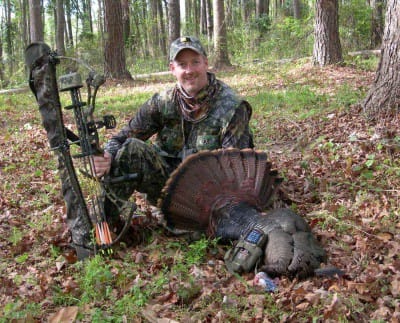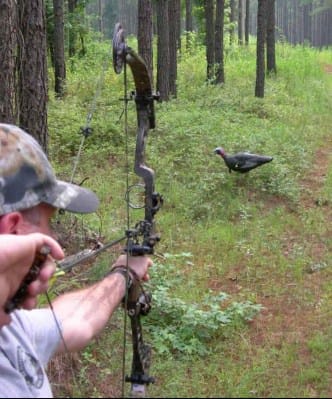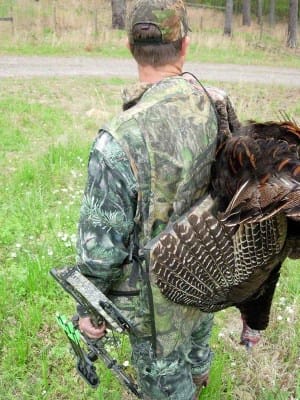
No other animal can change the way it presents its kill zone to an archer the way a wild turkey does. Walking, strutting, standing tall or leaning forward, each scenario poses different aiming situations. With deer or elk, it’s much easier to see if the animal is quartering away or broadside, but a turkey is a totally different ball game.
Accuracy is key
When bow hunting turkeys, your first priority should always be accuracy. Turkeys aren’t known for jumping the string. And it isn’t hard to get adequate penetration with any decent broadhead. Your current deer rig will work just fine.
Determine at what distance you can hit a tennis ball every time you shoot—that’s your maximum range. Practice from kneeling positions, inside blinds, behind trees, in front of trees—any conceivable setup you might find yourself in come spring.
Buy a good rangefinder and carry it with you. Knowing the exact distance makes you that much more deadly.
Practice with your broadheads as even some mechanicals can impact differently than field points. I favor mechanical heads for turkeys when bigger cutting diameters are preferred. Rage broadheads are tops on my list, but there are other good heads on the market. If you are willing to keep your shots at 20 yards or less, the Gobbler Guillotine by Arrowdynamic Solutions is death on a stick. You only have one aim point—the head. With its extreme cutting diameter it’s usually a matter of a kill or a clean miss.
Pick the right spot
Researching the positions of a turkey’s vitals and bone will help you place the best shot. Look at photos and cutaway charts. Better yet, if someone bags a tom early in the season, take some time to note how the thighs and wings sit in relation to the rest of the bird.

One of the best shots to make on a turkey is when he’s facing away in full strut. It can also be one of the trickiest. From behind you might not see that he has twisted his tail in an effort to showoff and isn’t straight away. A hit at the base of the tail would anchor a straightaway turkey while a turkey that has twisted will likely cheat death.
On a turkey standing upright, you have to determine if he’s broadside or slightly quartering, making a difference on where you should aim. Most people have a tendency to aim too high, especially on strutting birds. Most of a turkey’s vitals ride low. A hit too high or too far back will result in a lost turkey, where one too low should take out his thighs. A more forward shot can nail the wing butt. Taking out his flight gear is a good way to anchor a tom.
Englemeyer also has some specific thoughts on shot placement.
“My favorite shot is a perfectly profile bird with his back horizontal and his head in the relaxed ‘S’ position, just above the line of his back,” Englemeyer said. “Aiming where the wings connect to the body gives the shooter more room for error. A bird standing erect with his back facing me (e.g. alarm putting and walking away) is my second favorite. I hold at the base of the neck—just like a shotgun. It is fairly easy to pick a spot and has good room for error. Stray high or low and you’re in the zone. Yank the shot right or left and you’ve got a clean miss.”
Carefully check the shot you are about to take and consider all the variables before dropping the string.
If it were easy…
Sound complicated? Don’t panic. Bow hunters are naturals at taking on tough challenges. Success depends on doing your homework and honing your shooting skills. Besides, if you didn’t like a challenge you wouldn’t be a bow hunter in the first place.




